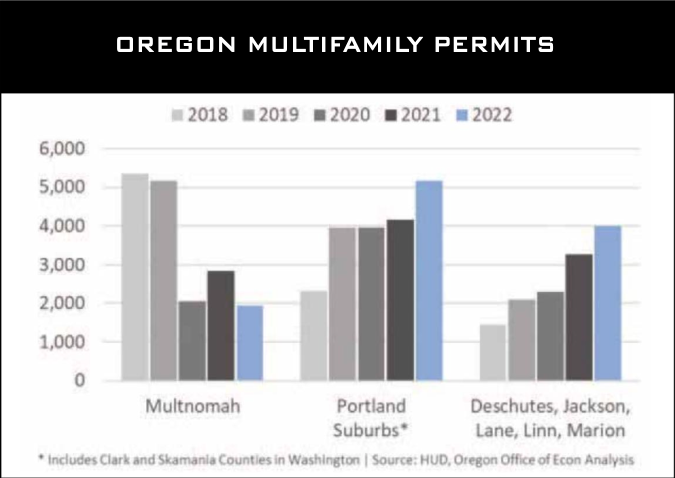Portland’s inclusionary zoning requirement is a slow-motion train-wreck; apartment permits are down by sixty percent in the City of Portland, while apartment permitting has more than doubled in the rest of the region
Inclusionary zoning in Portland has exhibited a Wile E. Coyote pattern: apartment starts stayed high initially, until a backlog of grandfathered units got built. Since then Portland apartment permits have plummeted.
The Wile E. Coyote Inclusionary Zoning Story in Portland
In December 2016, Portland’s City Council enacted a strong inclusionary housing requirement. Henceforth, all new apartment buildings in Portland would have to set-aside a portion of their units for low- and moderate income housing. Unlike other cities that either made compliance voluntary, or largely (or entirely) offset the cost of the added units with density bonuses or subsidies (or other quid pro quo), the Portland ordinance applied to nearly all apartment buildings larger than 20 units. The new requirement didn’t kick in until February 2017, and there was a land rush of developers who filed under the old rules. That produced a temporary flood of new apartment buildings, that have, over the past four years, mostly been built.
Investment markets work with lags for a variety of reasons. It takes time to plan, obtain permission for, and actually build new housing, and multi-family housing takes longer than single family housing. As a result, there’s a multi-year pipeline. When there are housing shortages, as there were in the early days of the recovery from the Great Recession, supply can’t expand as rapidly as demand, and rents get bid up. The reverse is also true; a glut of building in good times produces new apartment supply that holds down rents, at least for a while. That effect has concealed the negative consequences of Portland’s inclusionary zoning policy.
As we observed in May of 2019, the initial implementation of inclusionary zoning resulted in a kind of counter-intuitive acceleration of apartment construction.
. . . the first two years of inclusionary zoning in Portland have been a game-theory win-win for housing affordability. The threat of tougher future requirements prompted a whole lot of investment to happen much earlier than it otherwise would have, and new developments, added to those already under construction, have helped deliver a lot more new apartments in Portland.
Wile E. Coyote hits bottom in Portland
Back in 2019, we said that Portland’s apartment market was in the midst of the “don’t look down” portion of its Wile E. Coyote experience. The momentum from pre-IZ housing applications filled the construction pipeline, and led to a steady increase in the number of new apartment completions. But that initial surge of construction in response to the IZ grandfathering has petered out.
According to multifamily building permit data reported by Oregon State economist Josh Lehner, multifamily building permits in Multnomah County (mostly, but not entirely Portland), have fallen from more than 5,000 a year in 2018, to about 2,000 a year today.
And that’s not because of a weak regional market for apartments. Pretty much the opposite trend has been playing out in the Portland area suburbs. Back in 2018, there were only about 2,000 units per year being permitted in the suburban counties surrounding Portland; today there are more than 5,000 apartments. In the same broad metropolitan market, apartment permitting has fallen 60 percent in Portland and the same time it has increased two-and-a-half fold in the surrounding suburbs.
There’s other evidence as well. As we reported earlier, there’s been a collapse in demand for 20 to 30 unit apartment projects in Portland (these projects are just above the threshold for having to comply with the inclusionary housing requirement. There’s evidence that developers are under-building on available sites (something we’re stuck with for the life of the buildings, which is likely to be many decades).
By all measures, Wile E. Coyote has hit the desert floor.
A glass half full (actually 40 percent full in this case) optimist might point to the fact that apartment construction in Portland hasn’t fallen further. But ultimately, inclusionary zoning won’t wipe out all apartment construction. What it does mean though is that rents on market rate apartments have to rise high enough to compensate developers for paying the costs of constructing the below market rate units required by inclusionary zoning. And rents in Portland are high enough to make about 2,000 apartments a year pencil out for developers. That’s far fewer than we need. And it’s a symptom of the inherent contradiction built into the inclusionary requirement—it only works because it keeps rents high, which actually makes the overall affordability problem worse. And make no mistake, housing affordability is a problem of scale: a few hundred or even a few thousand discounted apartments to essentially nothing to ameliorate the affordability problem, and meanwhile, everyone who’s rent is set by the market pays a higher rent to produce a few trophy units. It’s as crazy and counterproductive as any of the ACME corporations sure-fire roadrunner catching gizmos.


